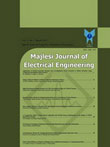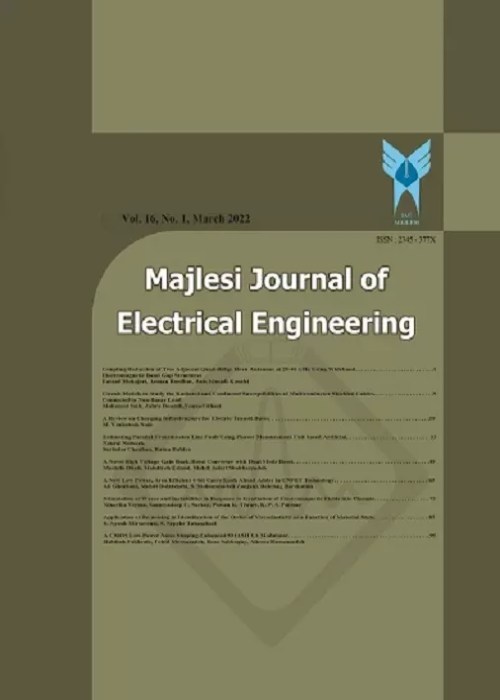فهرست مطالب

Majlesi Journal of Electrical Engineering
Volume:11 Issue: 3, Sep 2017
- تاریخ انتشار: 1396/06/15
- تعداد عناوین: 9
-
-
Page 1To meet increased demand in energy while reducing greenhouse gas emissions different renewable energy technologies are used. The wind power provides potential benefits as it is a clean, renewable, economic and domestically available power source. Building of sustainable wind farm is subject on many different factors. The aim of the paper is to contribute optimal turbines placement and integration to the electrical grid. For the goal, a mixed-integer non-linear optimization model for determination of maximum wind farm capacity is defined. Another linear optimization model is used to determine the minimum distance of wind turbines in the farm to the point of common coupling. The proposed approach is tested numerically for particular wind turbines type and given wind farm area. The testing results demonstrate the applicability of the proposed optimization models for determination of maximum wind farm capacity and minimum distance between wind farm and point of common coupling.Keywords: wind farm layout design, optimal planning, grid integration
-
Page 7Taking the advantages of alternative energy sources is currently a trending concept in the field of energy management. Meanwhile, microgrids and hybrid energy systems are of great importance due to their numerous benefits for both consumers and utility. This paper presents technical feasibility study of a hybrid energy system, including renewable and non-renewable resources and energy storage system, for electrification of a Disaster Management Basement located in Tehran, Iran. To simulate the potential power blackout caused by a disaster, the proposed system is simulated and optimized in off-grid mode, using HOMER simulation software. Since the disaster occurrence is unpredictable, while the system is simulated in a whole year, the results are analyzed in two winter and summer cases. Regarding reliability of the system, a sensitivity analysis is carried out. As the main result of the paper, it was found that renewables can act as good backup power systems in cases of shortages in conventional energy resources to ensure high reliability of the system.Keywords: Microgrid optimization, Energy management, HOMER, Reliability, Technical feasibility, Diesel price
-
Page 15In this paper, a comprehensive algorithm using modified invasive weed optimization is introduced for allocating distribution generation (DG) sources along with considering demand response (DR). Three aspects such as technical, economic and environmental are taken to account to define the optimized size and location for DG or DR. In addition, a new voltage fitness function is proposed for better improvisation of voltage profile. The study is done on 30-bus IEEE distribution system and to examine the proposed algorithm, three other optimization algorithms such as GA, PSO and DE are used. The simulation is carried out in MATLAB which shows excellent performance of proposed algorithm.Keywords: modified invasive optimization algorithm, demand response, distribution generation, DG allocation
-
Page 25In this paper, neuronal direct power control (DPC) strategy is applied for a doubly fed induction generator (DFIG) based wind energy generation system. Used in three level neutral point clamped (NPC) rectifiers, to directly control of the active and reactive power, switching vectors for rotor side converter were selected from the optimal switching table using the estimated stator flux position and the errors of the active and reactive power, also the grid side is controlled by direct power control based a grid voltage position to ensure a constant DC- link voltage. This approach is validated by using MATLAB/SIMULINK software and simulation results can prove the excellent performance of this control as improving power quality and stability of wind turbine.Keywords: Neuronal Direct power control (DPC), doubly fed induction generator (DFIG), three level neutral point clamped (NPC), active power, reactive power, DC-link, wind turbine
-
Page 33In this paper, new reactive power market structure is studied and presented. Active power flow by itself causes active and reactive losses. Considering reactive losses of active power flow in the reactive power market without paying any costs is the main purpose of this paper. For this purpose, new methodology for reactive power market structure is proposed. Hence, this study tries to improve reactive power market and create fair competition in reactive power generation through modifying the market structure. The advantage of this method is determining the mandatory region of units based on both active power output and its distance from the load. In order to stimulate the proposed method, IEEE 24 is used, and this method is compared with each the conventional reactive power market. As it will be shown, the total payment by ISO will be reduced by using this method.Keywords: restructured power system, power market, ancillary services, reactive power, power losses
-
Page 39due to the importance of providing reliable electricity for consumers in todays power networks, the need for studies in the field of power systems reliability is feeling increasingly considering inherent uncertainties of renewable sources. Therefore, the main challenge of this study is to provide an efficient technique for evaluating reliability of power systems considering economic transactions between generative companies and load sources and review the impact of renewable sources on system reliability. In this article, a solution is improved based on equivalent techniques of power system reliability considering the effect of changes in wind speed for producing wind power in the network. In addition, a new method has been provided for reliability assessment of transmission network to check the adequacy of transmission lines corresponding to each load point based on the maximum power that can be transferred. In this study, we have avoided to do iterative calculation for computing adequacy of transmission lines in load point indices when the load and generation level are variable. Finally, RTS IEEE is used as the sample network in order to evaluate the efficiency of the proposed algorithm. The results indicate the high efficiency of the proposed method for reducing reliability of computation time. uncertainty of renewable sources, reliability, bilateral contracts, network equivalent techniquesKeywords: uncertainty of renewable sources, reliability, bilateral contracts, network equivalent techniques
-
Page 53The development and installation of Distributed Generators (DGs) in distribution power networks turned these networks from a passive into active ones in power systems. Proper management and control of these resources can help to improve power quality, and increase security and effectiveness of power networks. The power management of DGs considering their operating cost along with reconfiguration of distribution network can reduced the cost of operation, including cost of energy losses, cost of power purchasing from the upstream network and cost of power generation by dispatchable DGs. In this study a new method is presented for daily reconfiguration of distribution network in presence of dispatchable DGs and renewable DGs in order to reduce the total operating cost of distribution companies. Dynamic modeling of renewable DGs based on uncertainty of their output, switching costs and varying load are considered in this paper. Finally the method has been tested in three stages on 16-Bus IEEE to demonstrate the effectiveness of proposed method.Keywords: Active Distribution Networks, Reconfiguration of Distribution Networks, Power Management, Network Operation Cost, Cost of Switching
-
Page 63In recent years, renewable energy technologies such as wind and solar have had significant growth and they can be used close to the consumption centers in order to remove high-voltage transmission lines. Using these sources with a power storage in the form of a hybrid system provides the increase of system reliability. The importance of achieving to the proper configuration of off-grid hybrid energy systems in order to reduce the cost of implementation and load continued support and system reliability, make the use of powerful software for optimization necessarily. Therefore, in the present study HOMER software is used to establish the best possible situation between cost and reliability (loss of power supply probability (LPSP)), hybrid energy system (consisting of wind turbines, photovoltaic panels and batteries) in the off-grid form to provide a load power remote from the grid. Data of load, wind speed and solar radiation are definite for Kurdeh village, the central district of the Larestan city. The system costs consist of initial investment and maintenance of equipment replacement. The considered prices are real and the used equipments are available in the market.Keywords: Hybrid System, Optimal Sizing, LPSP, Net Present Cost, Cost of Energy, HOMER Software
-
Page 71In this paper, the direct torque control torque based on space vector modulation (DTC-SVM) for permanent magnet synchronous generator connected to the variable-speed wind power generation system will be discussed. One of the most widely used in industry to convert voltage converters, converters back to back due to the very good features it is used. The main use space vector modulation voltage source inverters and current source is 3-phase. DTC method reduces the limitations and complexity of operation, so the price is Replay torque and flux machines that caused the DTC-SVM method is an alternative to it. The possibility of over-voltage matrix converter there on both sides. In some methods, sampling frequency and high frequency is required in others. The space vector modulation method sampling frequency is far less Direct Torque Control solution is a matrix converter.Keywords: PMSG, Direct Control Torque, ac-dc-ac convertor, Space vector Modulation, matrix converter


